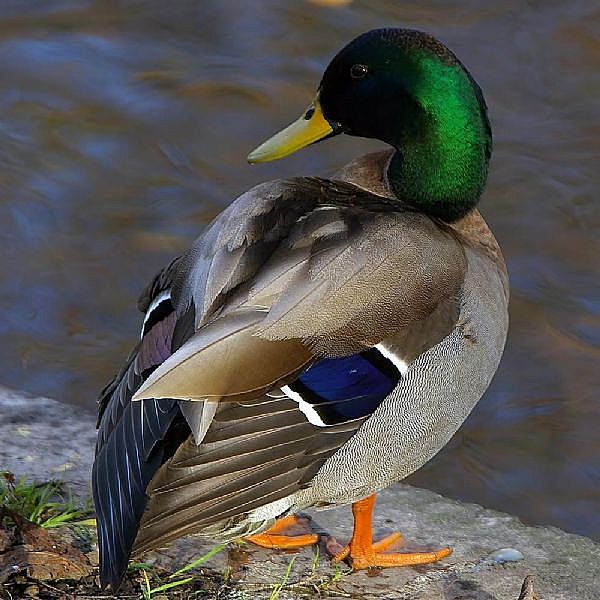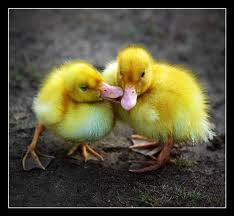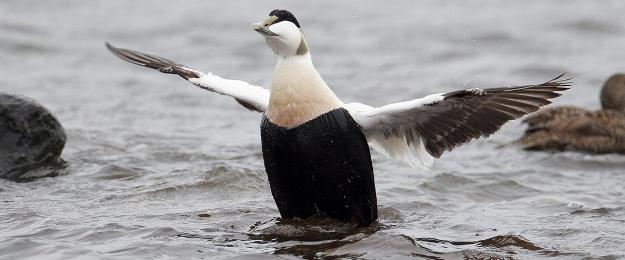Mallard Family
Zestful Mother
She’s a zestful little mother
Flew up a little Higher
Making a nest where it’s brighter
To keep away from the predator.
Not really being a pest
Just wanting a rest
From the normal test
To make her nest.
Cradled with ten
All special little kin
That she gladly covers
Some day they too will hover.
Time to leave the height
So mommy says hi
Yes one baby goes plunk
What a way to start life.
Really do need a hand
So a very nice man
Held out his hands
For them each to land.
The quick catch
Was quite a match
For each little bundle
Do not want to fumble.
Ten in a box
He went for a walk
At the river two blocks
With mother behind.
This family happy
With the mother quacking
Quack, quack, quack
At the river all back.

Ducks
These ducks quack
They have quite a batch
In the water they catch
Whatever they snatch.

THE MALLARD DUCK.
IN the accompanying picture is given a view of the common wild or Mallard duck, from whose parent stock came our well-known domestic duck. It is really a most beautiful bird; and if it were not so common, it would, undoubtedly, receive a greater amount of admiration than at present is given it. Its head and neck are a rich, glossy dark green, with a ring of white around the lower part of the neck.
The back is a rich chestnut brown, merging into black on the upper part of the tail. The four central tail feathers are black, and curl over; while the rest of the tail feathers are gray, edged with white. The wings are shining purple, snowy white, and velvety black; the breast is chestnut, and the under part white, penciled with dark lines. So closely do the tame ducks resemble their wild brethren, that an inexperienced eye could hardly perceive the difference between them.
The female is not nearly so beautiful as the male, as her plumage is a dull brown, and her wings but slightly tipped with white.
During the summer months, such a change takes place in the plumage of the drake that he can hardly be distinguished from his less pretentious mate. In describing this change, a naturalist says: "About the 24th of May, the breast and back of the drake exhibit the first appearance of a change of color. In a few days after this, the curled feathers above the tail drop out, and gray feathers begin to appear among the lovely green plumage which surrounds the eyes. Each succeeding day now brings marks of rapid change. By the 23d of June, scarcely one single green feather is to be seen on the head and neck of the bird. By the 6th of July, every feather of the former brilliant plumage has disappeared, and the male has received a garb like that of the female, though of a somewhat darker tint. In the early part of August, this new plumage begins to drop off gradually; and by the 10th of October, the drake will appear again in all his rich magnificence of dress."
Its favorite haunts are on little inland ponds' in the western and southern portions of the United States, where it is commonly seen from autumn till spring. It mates and breeds in the far North, usually during the months of February and March,
but sometimes at even an earlier period than this. It builds its nest near the water, close to the ground, in some sedgy, sheltered spot, and there lays its eggs, from eight to eleven in number.
They are rather large, and of a greenish white color. The nest itself is made of dried grasses, and is lined with down plucked from the mother duck's breast. She never leaves the nest for food after she has commenced setting, without her mate first makes sure that there is no danger near.
The ducks find enemies in water as well as on land, the large fish in the lakes, where they are hatched, being very fond of the young ones.
About September or October the little ducks are full-grown, and, with their parents, fly away to a warmer climate.
Wild ducks are very fine eating, and hunters resort to every device to capture so desirable game. The most common method is to build "blinds" along the shore: These are little coverts made so as to resemble a thick patch of reeds. Behind this the hunter stations himself, with his gun, and shoots them as they fly over. Or he places in front of this innocent clump of rushes a wooden duck as a decoy, and then he has a fine chance to shoot the ducks as they unsuspectingly fly down to make the acquaintance of the stranger. Foolish indeed it seems for them to allow themselves to be led to destruction by painted decoys; yet boys and girls not unfrequently use as little caution in making new acquaintances.
W. E. L


BIRDS USE THEIR BILLS.
THE birds do not have hands, but they have something that answers just as well. Their bills are as useful to them as your hands are to you.
They are not all, made alike, or used in the same way. The duck has a very queer bill. It is made so because this bird has to find its food under water. It cannot see what it gets, and must feel instead.
So this bill is filled with nerves for the purpose:
It has a row of little points, too, all around the edge, something like teeth. But how does the duck use it?
Let us see.
When searching for food, it thrusts this bill down, and brings it up full of mud. Now in the mud are the very things the bird lives upon.
These little nerves tell it just what is good to eat. What is not good is sent out through these queer points, just as if it were a sifter. The nerves in this funny sieve take very good, care that nothing shall be lost that is worth eating.
You know all about the little birds that build nests with their bills, and what wonderful things
they are. Some can sew very well with their beaks; of course they use their feet too.
Our Little Ones.

Eider Duck
IN a very cold country far away in the Northern Ocean,—Iceland it is called,—there are thousands of these beautiful birds. Wherever you step, you find one.
You think they would not like to stay where the rivers are always frozen, and snow is on the ground all the long year, with only a few days of sunshine. But they do, because they can be very quiet there, and do pretty much as they like.
Their nests are a sort of little mattress made of drift-grass and sea-weed, over which they spread a bed of finest down. The careful mother plucks this down from her own breast, heaping it up in a sort of thick, fluffy roll around the edge of the nest. You know that while she is sitting on her eggs, she must sometimes leave the nest for food. The weather is so cold that before she goes, she care-fully turns this roll of down over the eggs, to keep them warm until her return. A great deal of money is made by the Icelanders in selling the down. When it is taken from the nest, the little mother goes to work just as carefully as before, and makes it all over. But if they take it the second time, and her home is left with bare walls, her breast bare too, what is she to do?
In a moment the male bird comes to her help, and plucks the down off his own breast. His feathers are whiter, though not so soft. This down is so light that it takes a great many feathers to weigh anything at all. If you should fill your father's hat with them, they would not weigh an ounce. After all, they would make you the warmest covering in the world.
Mrs. G. Hall
